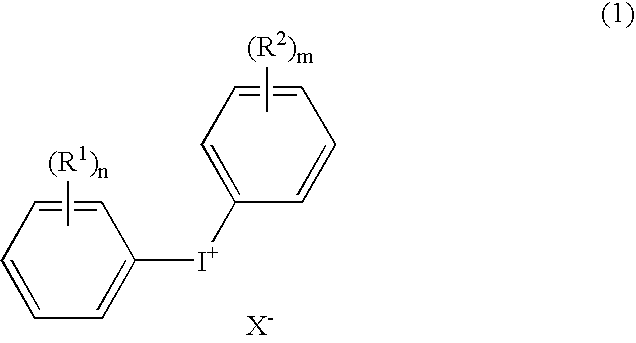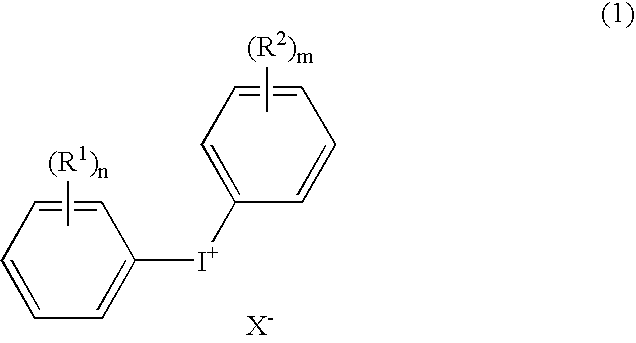Positive type radiation-sensitive resin composition
a radiation-sensitive resin and composition technology, applied in the field of positive-type radiation-sensitive resin compositions, can solve the problems of pattern collapse, insufficient resolution and pattern profiles, and difficult microfabrication with a line width of a sub-quarter micron order using near ultraviolet rays, so as to increase the hydrophobicity of the generator, reduce the dissolution rate, and reduce the effect of dissolution
- Summary
- Abstract
- Description
- Claims
- Application Information
AI Technical Summary
Benefits of technology
Problems solved by technology
Method used
Image
Examples
reference example 1
Synthesis of Acid-Labile Group-Containing Resin (B-1)
[0111] 101 g of p-acetoxystyrene, 5 g of styrene, 42 g of p-t-butoxystyrene, 6 g of azobisisobutyronitrile (AIBN), and 1 g of t-dodecyl mercaptan were dissolved in 160 g of propylene glycol monomethyl ether. The mixture was polymerized while maintaining the temperature at 70° C. for 16 hours under nitrogen atmosphere. After the polymerization, the resulting solution was added dropwise to 2,000 g of n-hexane to coagulate the resin. Then, another 150 g of propylene glycol monomethyl ether was added to the resin. 300 g of methanol, 80 g of triethylamine, and 15 g of water were further added to the resin and hydrolyzed for 8 hours with refluxing at boiling point. After the reaction, the solvent and triethylamine were evaporated under reduced pressure. The resin was dissolved in acetone to be solid content of 20 wt %. The resulting resin solution was added dropwise to 2,000 g of water to coagulate the resin. The produced white powder ...
reference example 2
Synthesis of Acid-Labile Group-Containing Resin (B-2)
[0114] 100 g of p-acetoxystyrene, 25 g of t-butyl acrylate, 18 g of styrene, 6 g of azobisisobutyronitrile (AIBN), and 1 g of t-dodecyl mercaptan were dissolved in 230 g of propylene glycol monomethyl ether. The mixture was polymerized while maintaining the temperature at 70° C. for 16 hours under nitrogen atmosphere. After the polymerization, the resulting solution was added dropwise to 2,000 g of n-hexane to coagulate the resin. Then, another 150 g of propylene glycol monomethyl ether was added to the resin. 300 g of methanol, 80 g of triethylamine, and 15 g of water were further added to the resin and hydrolyzed for 8 hours with refluxing at boiling point. After the reaction, the solvent and triethylamine were evaporated under reduced pressure. The resin was dissolved in acetone to be solid content of 20 wt %. The resulting resin solution was added dropwise to 2,000 g of water to coagulate the resin. The produced white powder ...
reference example 3
Synthesis of Acid-Labile Group-Containing Resin (B-3)
[0116] 25 g of a copolymer molar of p-hydroxystyrene and p-t-butoxystyrene (copolymerization molar ratio 90:10) was dissolved in 100 g of n-butyl acetate. Nitrogen gas was bubbled through the solution for 30 minutes. After the addition of 3.3 g of ethyl vinyl ether and 1 g of pyridinium p-toluenesulfonate as a catalyst, the mixture was reacted at room temperature for 12 hours. The resulting solution was added dropwise to 2,000 g of 1 wt % ammonium aqueous solution to coagulate the resin. The resin was filtered and dried overnight in a drier at 50° C. in the vacuum drying apparatus.
[0117] The resin was found to have Mw and Mw / Mn of 13,000 and 1.01 respectively. As a result of 13C-NMR analysis, the resin was found to have a structure in which 23 mol % of hydrogen atoms of the phenolic hydroxyl group in poly(p-hydroxystyrene) was replaced by ethoxyethyl groups, and 10 mol % by t-butyl groups. This resin is referred to as “resin (B-...
PUM
| Property | Measurement | Unit |
|---|---|---|
| width | aaaaa | aaaaa |
| wavelength | aaaaa | aaaaa |
| wavelength | aaaaa | aaaaa |
Abstract
Description
Claims
Application Information
 Login to View More
Login to View More - R&D
- Intellectual Property
- Life Sciences
- Materials
- Tech Scout
- Unparalleled Data Quality
- Higher Quality Content
- 60% Fewer Hallucinations
Browse by: Latest US Patents, China's latest patents, Technical Efficacy Thesaurus, Application Domain, Technology Topic, Popular Technical Reports.
© 2025 PatSnap. All rights reserved.Legal|Privacy policy|Modern Slavery Act Transparency Statement|Sitemap|About US| Contact US: help@patsnap.com



